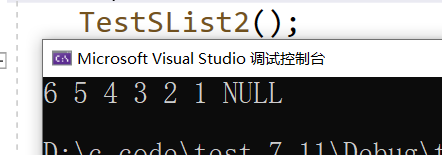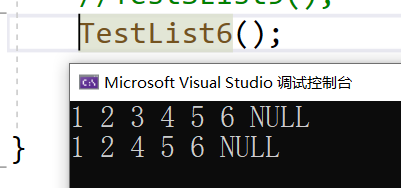写在前面
博主教你用最简单的方式,让你彻底理解链表,实现链表。 学习链表,要多调试,多画图,自己多实现几遍,拿下链表不在话下!
本节目标
1.链表表示和实现(单链表+双向链表)
2.链表的常见OJ题
3.顺序表和链表的区别和联系
链表表示和实现(单链表+双向链表)
顺序表的问题及思考问题:
- 中间/头部的插入删除,时间复杂度为O(N)
- 增容需要申请新空间,拷贝数据,释放旧空间。会有不小的消耗
- 增容一般是呈2倍的增长,势必会有一定的空间浪费。例如当前容量为100,满了以后增容到200,我们再继续插入了5个数据,后面没有数据插入了,那么就浪费了95个数据空间。
- 思考:如何解决以上问题呢?下面给出了链表的结构来看看。
链表的概念
链表是一种物理存储结构上非连续、非顺序的存储结构,数据元素的逻辑顺序是通过链表中的指针链接次序实现的
逻辑结构
 想必大家看的都是链表的逻辑结构,其实真实并不存在连接两个链表的箭头,为了更好理解罢了。箭头代表前面的节点存了,后面节点的指针。
想必大家看的都是链表的逻辑结构,其实真实并不存在连接两个链表的箭头,为了更好理解罢了。箭头代表前面的节点存了,后面节点的指针。
物理结构
物理结构就是真正的结构,便于初学者学习!
 是不是突然对链表有了更深刻的理解!
是不是突然对链表有了更深刻的理解!
单链表的实现
// 1、无头+单向+非循环链表增删查改实现
// 动态申请一个节点
SListNode* BuySListNode(SLTDateType x);
// 单链表打印
void SListPrint(SListNode* plist);
// 单链表尾插
void SListPushBack(SListNode** pplist, SLTDateType x);
// 单链表的头插
void SListPushFront(SListNode** pplist, SLTDateType x);
// 单链表的尾删
void SListPopBack(SListNode** pplist);
// 单链表头删
void SListPopFront(SListNode** pplist);
// 单链表查找
SListNode* SListFind(SListNode* plist, SLTDateType x);
// 单链表在pos位置之前插入x
void SListInsert(SListNode** pplist, SListNode* pos, SLTDateType x);
// 单链表删除pos位置的值
void SListErase(SListNode** pplist, SListNode* pos);
链表节点创建
链表的创建也是用结构体创建。
//类型创建
typedef int SLDataType;
typedef struct SListNode
{
SLDataType date; //存值
struct SListNode* next; //存下一节点的指针
}SLNode;
// 动态申请一个节点
SLTNode* BuySListNode(SLTDataType x)
{
SLTNode* newnode = (SLTNode*)malloc(sizeof(SLTNode));
newnode->date = x;
newnode->next = NULL;
return newnode;
}
// 打印
void SListPrint(SLTNode* phead)
{
while (phead != NULL)
{
printf("%d ", phead->date);
phead = phead->next;
}
printf("NULL\n");
}
//尾插
void SListPushBack(SLTNode** pphead, SLTDataType x)
{
if (*pphead == NULL)
{
*pphead = BuySListNode(x);
}
else
{
SLTNode* tail = *pphead;
while (tail->next)
{
tail = tail->next;
}
tail->next = BuySListNode(x);
}
}
//头插接口测试
void TestSList2()
{
SLTNode* plist = NULL;
SListPushFront(&plist, 1);
SListPushFront(&plist, 2);
SListPushFront(&plist, 3);
SListPushFront(&plist, 4);
SListPushFront(&plist, 5);
SListPushFront(&plist, 6);
SListPrint(plist);
}

//头插
void SListPushFront(SLTNode** pphead, SLTDataType x)
{
if (!*pphead)
{
*pphead= BuySListNode(x);
}
else
{
SLTNode* first = BuySListNode(x);
first->next = *pphead;
*pphead = first;
}
}
//头插接口测试
void TestSList2()
{
SLTNode* plist = NULL;
SListPushFront(&plist, 1);
SListPushFront(&plist, 2);
SListPushFront(&plist, 3);
SListPushFront(&plist, 4);
SListPushFront(&plist, 5);
SListPushFront(&plist, 6);
SListPrint(plist);
}

//头删
void SListPopFront(SLTNode** pphead)
{
if (!*pphead)
{
return;
}
else
{
*pphead = (*pphead)->next;
}
}
//头删接口测试
void TestSList3()
{
SLTNode* plist = NULL;
SListPushFront(&plist, 1);
SListPushFront(&plist, 2);
SListPushFront(&plist, 3);
SListPushFront(&plist, 4);
SListPushFront(&plist, 5);
SListPushFront(&plist, 6);
SListPrint(plist);
SListPopFront(&plist);
SListPopFront(&plist);
SListPopFront(&plist);
SListPopFront(&plist);
SListPrint(plist);
}

//尾删
void SListPopBack(SLTNode** pphead)
{
//1头结点为空
//2只有一个节点
//3多个节点
if (*pphead == NULL)
{
return;
}
else if ((*pphead)->next ==NULL)
{
*pphead = NULL;
free(*pphead);
}
else
{
SLTNode* tail = *pphead;
SLTNode* ret = *pphead;
while (tail->next)
{
ret = tail;
tail = tail->next;
}
tail = NULL;
ret->next = NULL;
free(tail);
}
}
//尾删接口测试
void TestSList4()
{
SLTNode* plist = NULL;
SListPushFront(&plist, 1);
SListPushFront(&plist, 2);
SListPushFront(&plist, 3);
SListPushFront(&plist, 4);
SListPushFront(&plist, 5);
SListPushFront(&plist, 6);
SListPrint(plist);
SListPopBack(&plist);
SListPopBack(&plist);
SListPopBack(&plist);
SListPopBack(&plist);
SListPrint(plist);
}

//查找节点x位置并返回节点位置
SLTNode* SListFind(SLTNode* phead, SLTDataType x)
{
if (phead == NULL) //节点为空
{
return NULL;
}
else
{
SLTNode *ret= phead;
while (ret)
{
if (ret->date == x) //找到了
{
return ret;
}
ret = ret->next;
}
return NULL; //找不到
}
}
// 在pos的前面插入x
void SListInsert(SLTNode** pphead, SLTNode* pos, SLTDataType x)
{
SLTNode* newnode = BuySListNode(x);
if (*pphead == NULL)
{
return;
}
else if(*pphead==pos)
{
*pphead = newnode;
newnode->next = pos;
}
else
{
SLTNode* ret = *pphead;
while (ret->next != pos)
{
ret = ret->next;
}
ret->next = newnode;
newnode->next = pos;
}
}
//任意位置查找插入测试
void TestSList5()
{
SLTNode* plist = NULL;
SListPushFront(&plist, 1);
SListPushFront(&plist, 2);
SListPushFront(&plist, 3);
SListPushFront(&plist, 4);
SListPushFront(&plist, 5);
SListPushFront(&plist, 6);
SListPrint(plist);
SLTNode* pos = SListFind(plist,3);
if (pos)
{
SListInsert(&plist,pos,0);
}
SListPrint(plist);
}

//删除pos位置的值
void SListErase(SLTNode** pphead, SLTNode* pos)
{
if (*pphead==NULL)
{
return;
}
else if (*pphead == pos)
{
*pphead = NULL;
}
else
{
SLTNode* ret = *pphead;
while (ret->next != pos)
{
ret = ret->next;
}
ret->next = pos->next;
pos = NULL;
free(pos);
}
}
//任意位置修改接口测试
void TestList6()
{
SLTNode* plist = NULL;
SListPushBack(&plist, 1);
SListPushBack(&plist, 2);
SListPushBack(&plist, 3);
SListPushBack(&plist, 4);
SListPushBack(&plist, 5);
SListPushBack(&plist, 6);
SListPrint(plist);
SLTNode* pos = SListFind(plist, 3);
if (pos)
{
SListErase(&plist, pos);
}
SListPrint(plist);
}

单链表的实现就学习到这里,还有很多接口,等以后我们再学习吧,单链表结构简单但是实现复杂,我们下期博客学习双链表的实现!结构复杂,实现简单…未完待续····
























 2120
2120











 被折叠的 条评论
为什么被折叠?
被折叠的 条评论
为什么被折叠?










